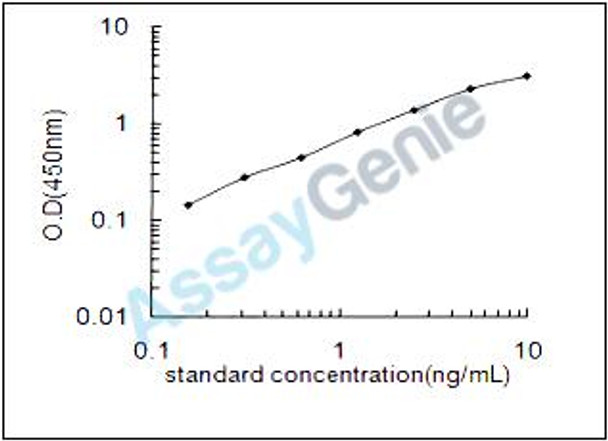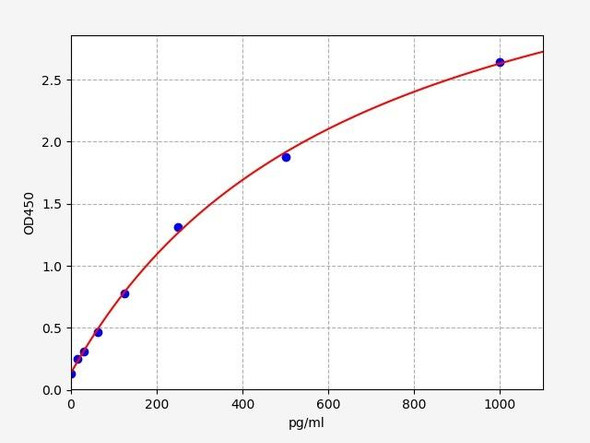Description
Human Cryptic protein (CFC1) ELISA Kit
The Human Cryptic Protein CFC1 ELISA Kit is specifically designed for the precise measurement of cryptic protein CFC1 levels in human samples including serum, plasma, and cell culture supernatants. This kit offers outstanding sensitivity and specificity, ensuring accurate and reproducible results for various research applications.Cryptic protein CFC1 is a key player in biological processes such as cell development and differentiation.
It is known to be implicated in various diseases, making it a valuable biomarker for studying conditions like cancer, cardiovascular diseases, and neurological disorders. With this ELISA kit, researchers can gain valuable insights into the role of cryptic protein CFC1 in disease progression and potentially develop targeted therapies.
| Product Name: | Human Cryptic protein (CFC1) ELISA Kit |
| SKU: | HUEB1799 |
| Size: | 96T |
| Target: | Human Cryptic protein (CFC1) |
| Synonyms: | Cryptic family protein 1 |
| Assay Type: | Sandwich |
| Detection Method: | ELISA |
| Reactivity: | Human |
| Detection Range: | 0.156-10ng/mL |
| Sensitivity: | 0.089ng/mL |
| Intra CV: | 5.8% | ||||||||||||||||||||
| Inter CV: | 7.7% | ||||||||||||||||||||
| Linearity: |
| ||||||||||||||||||||
| Recovery: |
| ||||||||||||||||||||
| Function: | NODAL coreceptor involved in the correct establishment of the left-right axis. May play a role in mesoderm and/or neural patterning during gastrulation. |
| Uniprot: | P0CG37 |
| Sample Type: | Serum, plasma, tissue homogenates, cell culture supernates and other biological fluids |
| Specificity: | Natural and recombinant human Cryptic protein |
| Subcellular Location: | Cell membrane Lipid-anchor GPI-anchor Secreted Does not exhibit a typical GPI-signal sequence. The C-ter hydrophilic extension of the GPI-signal sequence reduces the efficiency of processing and could lead to the production of an secreted unprocessed form. This extension is found only in primates. |
| Storage: | Please see kit components below for exact storage details |
| Note: | For research use only |
| UniProt Protein Function: | CFC1: NODAL coreceptor involved in the correct establishment of the left-right axis. May play a role in mesoderm and/or neural patterning during gastrulation. Defects in CFC1 are the cause of visceral heterotaxy autosomal type 2 (HTX2). A form of visceral heterotaxy, a complex disorder due to disruption of the normal left-right asymmetry of the thoracoabdominal organs. It results in an abnormal arrangement of visceral organs, and a wide variety of congenital defects including cardiac malformations and situs inversus or situs ambiguus. Defects in CFC1 are a cause of transposition of the great arteries dextro-looped type 2 (DTGA2). A congenital heart defect consisting of complete inversion of the great vessels, so that the aorta incorrectly arises from the right ventricle and the pulmonary artery incorrectly arises from the left ventricle. This creates completely separate pulmonary and systemic circulatory systems, an arrangement that is incompatible with life. Patients often have atrial and/or ventricular septal defects or other types of shunting that allow some mixing between the circulations in order to support life minimally, but surgical intervention is always required. Defects in CFC1 are a cause of conotruncal heart malformations (CTHM). CTHM consist of cardiac outflow tract defects, such as tetralogy of Fallot, pulmonary atresia, double-outlet right ventricle, truncus arteriosus communis, and aortic arch anomalies. |
| UniProt Protein Details: | Protein type:Membrane protein, GPI anchor Chromosomal Location of Human Ortholog: 2q21.1 Cellular Component: plasma membrane; extracellular region Biological Process: gastrulation; determination of left/right symmetry Disease: Heterotaxy, Visceral, 2, Autosomal; Conotruncal Heart Malformations; Transposition Of The Great Arteries, Dextro-looped 2 |
| NCBI Summary: | This gene encodes a member of the epidermal growth factor (EGF)- Cripto, Frl-1, and Cryptic (CFC) family, which are involved in signalling during embryonic development. Proteins in this family share a variant EGF-like motif, a conserved cysteine-rich domain, and a C-terminal hydrophobic region. The protein encoded by this gene is necessary for patterning the left-right embryonic axis. Mutations in this gene are associated with defects in organ development, including autosomal visceral heterotaxy and congenital heart disease. Alternatively spliced transcript variants encoding multiple isoforms have been observed for this gene. [provided by RefSeq, Jul 2012] |
| UniProt Code: | P0CG37 |
| NCBI GenInfo Identifier: | 46854798 |
| NCBI Gene ID: | 55997 |
| NCBI Accession: | AAH69508.1 |
| UniProt Secondary Accession: | P0CG37,Q53T05, Q9GZR3, B2RCY0, B9EJD3, |
| UniProt Related Accession: | P0CG37 |
| Molecular Weight: | 24,612 Da |
| NCBI Full Name: | Cryptic |
| NCBI Synonym Full Names: | cripto, FRL-1, cryptic family 1 |
| NCBI Official Symbol: | CFC1 |
| NCBI Official Synonym Symbols: | HTX2; CFC1B; DTGA2; CRYPTIC |
| NCBI Protein Information: | cryptic protein; cryptic family protein 1; heterotaxy 2 (autosomal dominant) |
| UniProt Protein Name: | Cryptic protein |
| UniProt Synonym Protein Names: | Cryptic family protein 1 |
| Protein Family: | Cryptic protein |
| UniProt Gene Name: | CFC1 |
| UniProt Entry Name: | CFC1_HUMAN |
| Component | Quantity (96 Assays) | Storage |
| ELISA Microplate (Dismountable) | 8×12 strips | -20°C |
| Lyophilized Standard | 2 | -20°C |
| Sample Diluent | 20ml | -20°C |
| Assay Diluent A | 10mL | -20°C |
| Assay Diluent B | 10mL | -20°C |
| Detection Reagent A | 120µL | -20°C |
| Detection Reagent B | 120µL | -20°C |
| Wash Buffer | 30mL | 4°C |
| Substrate | 10mL | 4°C |
| Stop Solution | 10mL | 4°C |
| Plate Sealer | 5 | - |
Other materials and equipment required:
- Microplate reader with 450 nm wavelength filter
- Multichannel Pipette, Pipette, microcentrifuge tubes and disposable pipette tips
- Incubator
- Deionized or distilled water
- Absorbent paper
- Buffer resevoir
*Note: The below protocol is a sample protocol. Protocols are specific to each batch/lot. For the correct instructions please follow the protocol included in your kit.
Allow all reagents to reach room temperature (Please do not dissolve the reagents at 37°C directly). All the reagents should be mixed thoroughly by gently swirling before pipetting. Avoid foaming. Keep appropriate numbers of strips for 1 experiment and remove extra strips from microtiter plate. Removed strips should be resealed and stored at -20°C until the kits expiry date. Prepare all reagents, working standards and samples as directed in the previous sections. Please predict the concentration before assaying. If values for these are not within the range of the standard curve, users must determine the optimal sample dilutions for their experiments. We recommend running all samples in duplicate.
| Step | |
| 1. | Add Sample: Add 100µL of Standard, Blank, or Sample per well. The blank well is added with Sample diluent. Solutions are added to the bottom of micro ELISA plate well, avoid inside wall touching and foaming as possible. Mix it gently. Cover the plate with sealer we provided. Incubate for 120 minutes at 37°C. |
| 2. | Remove the liquid from each well, don't wash. Add 100µL of Detection Reagent A working solution to each well. Cover with the Plate sealer. Gently tap the plate to ensure thorough mixing. Incubate for 1 hour at 37°C. Note: if Detection Reagent A appears cloudy warm to room temperature until solution is uniform. |
| 3. | Aspirate each well and wash, repeating the process three times. Wash by filling each well with Wash Buffer (approximately 400µL) (a squirt bottle, multi-channel pipette,manifold dispenser or automated washer are needed). Complete removal of liquid at each step is essential. After the last wash, completely remove remaining Wash Buffer by aspirating or decanting. Invert the plate and pat it against thick clean absorbent paper. |
| 4. | Add 100µL of Detection Reagent B working solution to each well. Cover with the Plate sealer. Incubate for 60 minutes at 37°C. |
| 5. | Repeat the wash process for five times as conducted in step 3. |
| 6. | Add 90µL of Substrate Solution to each well. Cover with a new Plate sealer and incubate for 10-20 minutes at 37°C. Protect the plate from light. The reaction time can be shortened or extended according to the actual color change, but this should not exceed more than 30 minutes. When apparent gradient appears in standard wells, user should terminatethe reaction. |
| 7. | Add 50µL of Stop Solution to each well. If color change does not appear uniform, gently tap the plate to ensure thorough mixing. |
| 8. | Determine the optical density (OD value) of each well at once, using a micro-plate reader set to 450 nm. User should open the micro-plate reader in advance, preheat the instrument, and set the testing parameters. |
| 9. | After experiment, store all reagents according to the specified storage temperature respectively until their expiry. |
When carrying out an ELISA assay it is important to prepare your samples in order to achieve the best possible results. Below we have a list of procedures for the preparation of samples for different sample types.
| Sample Type | Protocol |
| Serum | If using serum separator tubes, allow samples to clot for 30 minutes at room temperature. Centrifuge for 10 minutes at 1,000x g. Collect the serum fraction and assay promptly or aliquot and store the samples at -80°C. Avoid multiple freeze-thaw cycles. If serum separator tubes are not being used, allow samples to clot overnight at 2-8°C. Centrifuge for 10 minutes at 1,000x g. Remove serum and assay promptly or aliquot and store the samples at -80°C. Avoid multiple freeze-thaw cycles. |
| Plasma | Collect plasma using EDTA or heparin as an anticoagulant. Centrifuge samples at 4°C for 15 mins at 1000 × g within 30 mins of collection. Collect the plasma fraction and assay promptly or aliquot and store the samples at -80°C. Avoid multiple freeze-thaw cycles. Note: Over haemolysed samples are not suitable for use with this kit. |
| Urine & Cerebrospinal Fluid | Collect the urine (mid-stream) in a sterile container, centrifuge for 20 mins at 2000-3000 rpm. Remove supernatant and assay immediately. If any precipitation is detected, repeat the centrifugation step. A similar protocol can be used for cerebrospinal fluid. |
| Cell culture supernatant | Collect the cell culture media by pipette, followed by centrifugation at 4°C for 20 mins at 1500 rpm. Collect the clear supernatant and assay immediately. |
| Cell lysates | Solubilize cells in lysis buffer and allow to sit on ice for 30 minutes. Centrifuge tubes at 14,000 x g for 5 minutes to remove insoluble material. Aliquot the supernatant into a new tube and discard the remaining whole cell extract. Quantify total protein concentration using a total protein assay. Assay immediately or aliquot and store at ≤ -20 °C. |
| Tissue homogenates | The preparation of tissue homogenates will vary depending upon tissue type. Rinse tissue with 1X PBS to remove excess blood & homogenize in 20ml of 1X PBS (including protease inhibitors) and store overnight at ≤ -20°C. Two freeze-thaw cycles are required to break the cell membranes. To further disrupt the cell membranes you can sonicate the samples. Centrifuge homogenates for 5 mins at 5000xg. Remove the supernatant and assay immediately or aliquot and store at -20°C or -80°C. |
| Tissue lysates | Rinse tissue with PBS, cut into 1-2 mm pieces, and homogenize with a tissue homogenizer in PBS. Add an equal volume of RIPA buffer containing protease inhibitors and lyse tissues at room temperature for 30 minutes with gentle agitation. Centrifuge to remove debris. Quantify total protein concentration using a total protein assay. Assay immediately or aliquot and store at ≤ -20 °C. |
| Breast Milk | Collect milk samples and centrifuge at 10,000 x g for 60 min at 4°C. Aliquot the supernatant and assay. For long term use, store samples at -80°C. Minimize freeze/thaw cycles. |










